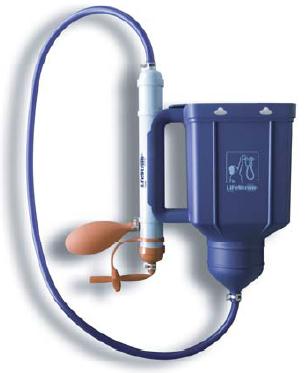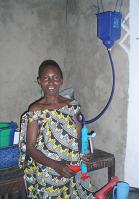LifeStraw Family
LifeStraw® Family is a point-of-use instant microbiological purifier that allows people to create their own homemade drinking water. The process of filtration begins when dirty water is poured into the pre-filter bucket. The 27 micron pre-filter removes coarser turbidity. At the bottom of the bucket, there is a halogen chamber that releases minimal chlorine to prevent the formation of biofilm on the membrane. Simple gravity forces the water through a tube and into the purification cartridge, which contains millions of tiny pores called capillary membranes (ultrafiltration, pore size of 20 nanometres) that retain bacteria, viruses, parasites and fine particles. Subsequently, clean and safe water is then ready to flow from the attached blue tap. The average flow rate is 8 - 10 litres/hour. As tested at the University of Arizona, the initial flow rate is 12-19 litres/hour. It decreases to 6-8 litres/hour when the filter reaches its 18.000 litre capacity. In this test, the water is contaminated with turbidity and organic carbon.
Suitable conditions
| Advantages | Disadvantages |
|---|---|
| - High flow rate with instant access to clean water - Auto-clog mechanism (safety aspect) |
- Concerns about safe storage when water is not consumed directly - High hanging (not very user friendly) |
|
|
Construction, operations and maintenance
Complete instructions for operation and maintenance are provided with the product.
Not much maintenance is required but the different parts of the LifeStraw Family need to be cleaned regularly. Membrane is prone to fouling. Dirt accumulated in the membranes can be released from the bottom of the device by pressing the squeeze bulb after use. The pre-filter should be cleaned approximately every 30 hours. The filter cartridge should be cleaned every 11 hours and the bucket about once a week. The red bulb provides backwashing for the filter cartridge. The dirt and impurities are disposed from the red exit.
There is no possibility for local manufacturing of the LifeStraw Family. The LifeStraw Family is produced by Vestergaard SA and tested at the University of Arizona for longevity and microbial reduction. Customers for LifeStraw® Family will most likely be the same as those who purchase LifeStraw®, and are mainly foreign governmental aid agencies, international relief and development organizations, foundations, and charities. Hence, the product will not be sold in individual units. In order to focus their efforts on developing products for people who need them the most, Vestergaard-Frandsen will concentrate on serving customers that can purchase large quantities of the product for the developing world.
Estimated Lifespan
It filters a minimum of 18.000 litres of water. The calculated lifespan is 3 years, based on the consumption of 10-15 litres/day which is an average size family of seven in sub-Saharan Africa (an adult man consumes up to 3 litres/day, an adult woman drinks at least 2 litres/day, and 5 children, each drinks 1 litre/day). This amount includes other consideration like increased water intake by pregnant/lactating women as well as manual labour in high temperatures.
Costs
| Capital cost | Operating cost | Replacement cost | Estimated 5 year cost | Cost / metre cubed treated |
|---|---|---|---|---|
| US$20 = €14,3/unit (purchase up to 500 units) US$17 = €12,1/unit (purchase between 500 and 3000 units) |
US$ 0 | US$ 0 | US$ 12-30 | US$1,1 = €0,79 US$ 0,94 = €0,67 |


